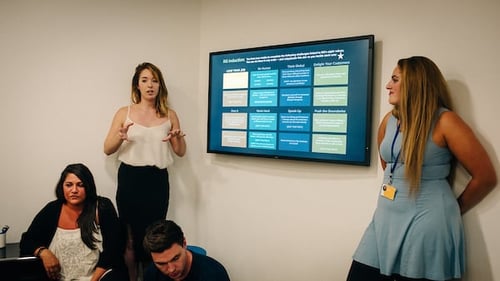Have you set yourself new years resolutions or some big goals to achieve this year? If you’re familiar with ‘Big Hairy Audacious Goals’ (or BHAGs), a term coined by James Collins and Jerry Porras in their book “Built to Last: Successful Habits of Visionaries,” you’ll know that these can be great motivators, and can set the energy and pace for a person or team.
The challenge, though, is we don’t always put the right things in place to set ourselves up for success. When that happens, we don’t experience the traction we expected when we started, we end up feeling deflated and demotivated… and then we give up.
How do we maintain that momentum and continue reaching our goals as the year goes on, no matter how big or audacious they seem?
You can’t improve what you don’t measure
The secret to creating a good BHAG or resolution is to make sure it’s something you can actually quantify and track. “I will be a better manager,” “We want to increase employee engagement,” “Our customer service will be better,” or “We will improve the user experience,” all have a positive sentiment – but they are not measurable.
If you can’t measure progress then you can’t measure success.
Improve employee engagement by how many points? And by when?
How do you currently measure customer service levels? How do you know they will be “better”? And better by how much?
How will you improve the user experience? And how will you quantify that this is happening? By reducing the number of support tickets or bugs reported? By increasing the number of new features you ship each week? All of the above?
Goals need to be quantified. That is, you need to attach a number to your goal.

If the goal for your business is to improve company culture, ask yourself how you will measure that. Is it a decrease in the number of people who leave/quit this year? Is it an increase in attendance at company meetings? Or an increase in the number of positive conversations your employees are having about their work, their peers and/or their leaders?
By setting quantifiable, measurable goals, you set yourself a target to work towards and a clear benchmark of what success looks like, and it becomes easier to check if you are on track.
Make yourself accountable
A few years ago I discovered an app that helps you track progress towards achieving goals by asking pre-programmed yes/no questions each day. The app spits out a graph at the end of the month, and you have the option to share this on your social networks.
While I wouldn’t necessarily advocate sharing all your goals and progress publicly to the entire world, you should share them with the people relevant to that goal. If it’s a personal goal, share it with a friend or your partner - someone who can support you but who’d also be comfortable to give you a metaphorical kick if you’re not doing what you said you would. If it’s a business goal, share it with your mentor, your shareholders and especially share it with the team who’s going to help you achieve it.
If there are no types of consequences or stakes, then you’re not going to do it. If you want to set and achieve your people goals, accountability will keep your eye on the prize.

Make achieving it easy
This advice seems straightforward, but it surprises me that we often try to do things the hard way and become roadblocks for ourselves.
Big goals are inspirational and it’s great to step out of your comfort zone, but that doesn’t mean you have to achieve the impossible every day. Every big goal or project can be split up into smaller, bite-sized chunks. You don’t write a novel in one day; you write bits of it every day for several weeks or months.
Similarly, you don’t become an amazing leader or change your business overnight. These things might seem abstract and hard to break down at first, so take some time to ask yourself: “What would this look like if it were easy?"
Break the big mountain down into stages of the journey, and then into steps. Ask yourself what it would look like without major barriers, and look for ways to avoid or get rid of those barriers. If the issue is time, then schedule in 15 minutes to work on that project daily. Or 30 minutes every other day. Or one extra hour at the end of every day.
Imagine the change at the end of the year if you set yourself three small things you can do every day, or every week, that will make you a better leader or build a better business?

To make introducing new things to your routine easier, combine these new actions or habits with things you already enjoy doing. BJ Fogg created a method called “Habit Stacking” – instead of introducing your new habit/action with a particular time and location, you pair it with a current habit; something you already do without thinking about it.
For example, if you want the great formula for recognising employees regularly, pair it with an action or habit you already do every day or week. You could say, “After I make my morning coffee, I will send an eCard,” or if you want more people to log into your company benefits platform, commit to raising it as a talking point at recurring meetings you’re already scheduled to attend.
The easier you make it for yourself to achieve these things daily, the more motivated you’ll become and the easier it becomes to create a habit.
Put it in your calendar
This is similar to making yourself accountable, but on a personal level. The truth is, if you don’t carve out time then you’ll never have time. So put the time to do the action or create the thing or repeat the habit in your calendar.
If you want to become better at recognising your employees, put time in your calendar to do it. If you want to become better at communicating with your team members, schedule a 5 minute stand-up and catch up at some point every day, or a 30 minute 1-to-1 every fortnight.
.png?width=500&name=ecard-delight-customers%20(1).png)
Recognise progress as and when it happens
This is probably the most important but overlooked part of achieving long-term goals. We forget the importance of acknowledging and rewarding progress. How often do we see leaders setting year-long strategies and only touch base if they see red on a board report? And while monthly company updates are surely better than quarterly or yearly ones, what happens to the people achieving things each day in between? Often, by the time the company acknowledges what’s been achieved, the energy and feeling of accomplishment has been overshadowed by the next task currently on their to-do list.
Frequent and continuous recognition and reward — whether it be a simple “thank you”, or by giving yourself or your teammates a treat or an experience — means you receive positive reinforcement during the journey.
Writing in Harvard Business Review about how to drive innovative work inside organisations, researchers Teresa Amabile and Steven J. Kramer coined the term “The Progress Principle”, which states that of all the things that can boost emotions, motivation, and perceptions during a workday, the single most important is making progress in meaningful work.
So… have you rewarded yourself for progress today? What about the people in your team who are helping you achieve your goals? Make a conscious decision to do this often, and you’ll see yourself knocking those BHAGs and New Year resolutions out of the park!
 Kylie Terrell
Kylie Terrell
